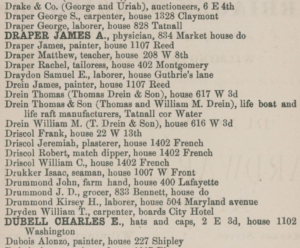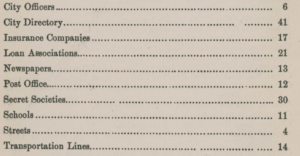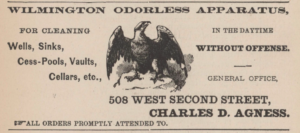
Wilmington City Directories: A Showcase of Services, Businesses and Life in Pre-Phone Book Wilmington
By David Cardillo, Digital Initiatives and Preservation
The Digital Initiatives and Preservation Department is currently in the process of digitizing volumes of the Wilmington City Directory, an annual publication from the 1800s through the mid-1900s that is best described as an early telephone book.
The telephone, however, wasn’t invented until 1875 – and not in homes until 1876 – so there were no telephone numbers to include in these directories. Instead, the directories listed addresses and occupations of the residents of Wilmington. These sections were analogous to the “white pages” of a phone book.
In the below example from the directory from 1880-1881, you can see a wide variety of occupations that can provide useful insight into a town during a particular time period in history:

An excerpt from the Wilmington City Directory for 1880-1881, page 153.
Here, we see physicians, teachers and laborers, as well as professions more unique to certain environments. The seaman Isaac Drukker, for instance, reminds us that Wilmington is a port city, and the farm hand John Drummond establishes the city as an agrarian pocket of America. There are also inclusions that are more ambiguous, like painter (of houses or canvases?), and those who inexplicably have no occupation listed at all.

An excerpt from the Wilmington City Directory for 1875-1876, page 3, unnumbered.
In addition to the addresses of individuals, the directories would often include information about city officers, insurance companies, newspapers, secret societies, schools, transportation lines and more. The secret societies referred to groups like the Freemasons, the Knights Templar and the Knights of Columbus – exclusive, member-based fraternities that often used codes, secret handshakes and some sort of initiation ceremony. Nevertheless, the term “secret” seems to go against the idea of advertising in a public directory.
Like any type of directory – be it a phone book, public listing or website – the Wilmington City Directories also contained advertisements.
Today, these advertisements can prove especially interesting when looking at the product or service being advertised and the way in which it was marketed. They also can speak to the way technologies have changed over time.
Take, for instance, this advertisement for an “odorless apparatus” from the 1878-79 volume. The vaguely named product could be an early version of a plumber’s snake, a plunger or even some sort of sump pump – items we’ve come to take for granted – but from the ad, all anyone knows for sure is that it can be used during the daytime, and that it is odorless and without offense.

An advertisement from the Wilmington City Directory of 1878-1879, page 57.
During this time, Wilmington was a coastal city with both an agricultural and industrial base that was undergoing a rapid increase in population. As a result, the city provides a nice microcosm of the rest of 19th-century America – and the directories provide a considerable insight into the local history and culture of the time.
Wilmington City Directories spanning from 1814 to 1881 are freely and digitally accessible on UDSpace by the Library, Museums and Press. These directories provide a snapshot of life in 19th-century Delaware through its listings of residents, institutions, organizations and businesses. Researchers with an interest in Delaware history and 19th-century America will likely find these resources particularly useful. This is a growing collection, with staff from the Digital Initiatives and Preservation Department continually adding more volumes to the repository.
